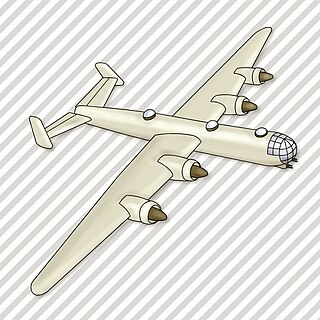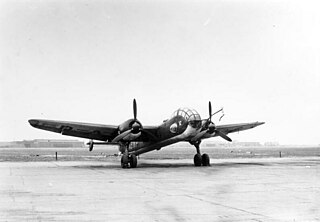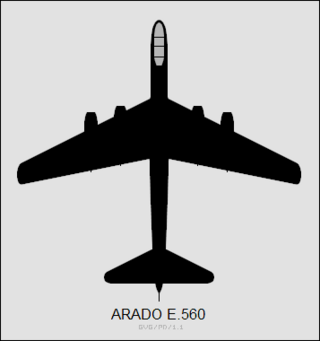
The Heinkel He 111 is a German airliner and bomber designed by Siegfried and Walter Günter at Heinkel Flugzeugwerke in 1934. Through development, it was described as a "wolf in sheep's clothing". Due to restrictions placed on Germany after the First World War prohibiting bombers, it was presented solely as a civil airliner, although from conception the design was intended to provide the nascent Luftwaffe with a heavy bomber.

The Arado Ar 234 Blitz is a jet-powered bomber designed and produced by the German aircraft manufacturer Arado. It was the world's first operational turbojet-powered bomber, seeing service during the latter half of the Second World War.

The Arado Ar 196 was a shipboard reconnaissance low-wing monoplane aircraft built by the German firm of Arado starting in 1936. The next year it was selected as the winner of a design contest and became the standard aircraft of the Kriegsmarine throughout World War II.

Heinkel Flugzeugwerke was a German aircraft manufacturing company founded by and named after Ernst Heinkel. It is noted for producing bomber aircraft for the Luftwaffe in World War II and for important contributions to high-speed flight, with the pioneering examples of a successful liquid-fueled rocket and a turbojet-powered aircraft in aviation history, with both Heinkel designs' first flights occurring shortly before the outbreak of World War II in Europe.

The Amerikabomber project was an initiative of the German Ministry of Aviation (Reichsluftfahrtministerium) to obtain a long-range strategic bomber for the Luftwaffe that would be capable of striking the United States from Germany, a round-trip distance of about 11,600 km (7,200 mi). The concept was raised as early as 1938, but advanced plans for such a long-range strategic bomber design did not begin to appear before Reichsmarschall Hermann Göring until early 1942. Various proposals were put forward, but these plans were all eventually abandoned as they were too expensive, too reliant on rapidly-diminishing materiel and production capacity, and/or technically unfeasible.

The Heinkel He 177 Greif (Griffin) was a long-range heavy bomber flown by the Luftwaffe during World War II. The introduction of the He 177 to combat operations was significantly delayed, by both problems with the development of its engines, and frequent changes to its intended role. Nevertheless, it was the only long-range, heavy bomber to become operational with the Luftwaffe during the war. The He 177 had a payload/range capability similar to that of four-engined heavy bombers used by the Allies in the European theatre.

The Heinkel He 277 was a four-engine, long-range heavy bomber design, originating as a derivative of the He 177, intended for production and use by the German Luftwaffe during World War II. The main difference was in its engines. The He 177 used two Daimler-Benz DB 606 "power system" engines, each of which consisted of two combined Daimler-Benz DB 601 engines, each DB 606 weighed 1.5 tons. The He 177A-3 and its successors used two DB 610 "power system" engines, each of which consisted of two combined Daimler-Benz DB 605 engines, each DB 610 weighed 1.5 tons. Due to problems with both the DB 606 and the DB 610, the He 277 was intended to use four unitized BMW 801E 14-cylinder radial engines, each mounted in an individual nacelle and each turning a three-blade, four-meter diameter propeller.

The Messerschmitt Me 264 was a long-range strategic bomber developed during World War II for the German Luftwaffe as its main strategic bomber. The design was later selected as Messerschmitt's competitor in the Reichsluftfahrtministerium's Amerikabomber programme, for a strategic bomber capable of attacking New York City from bases in France or the Azores.

Henschel's Hs 132 was a World War II dive bomber and interceptor aircraft of the German Luftwaffe that never saw service. The unorthodox design featured a top-mounted BMW 003 jet engine and the pilot in a prone position. The Soviet Army occupied the factory just as the Hs 132 V1 was nearing flight testing, the V2 and V3 being 80% and 75% completed.

Bomber B was a German military aircraft design competition organised just before the start of World War II to develop a second-generation high-speed bomber for the Luftwaffe. The new designs would be a direct successor to the Schnellbomber philosophy of the Dornier Do 17 and Junkers Ju 88, relying on high speed as its primary defence. Bomber B would be a much larger and more capable aircraft, with range and payload far greater than the Schnellbomber, besting the largest conventional designs then under consideration. The winning design was intended to form the backbone of the Luftwaffe's bomber force, replacing the wide collection of semi-specialized designs then in service. The Reich Air Ministry was so optimistic that more modest projects were generally cancelled; when the project failed the Luftwaffe was left with hopelessly outdated aircraft.

The Heinkel He 343 was a quadjet bomber project designed by the German aircraft manufacturer Ernst Heinkel Flugzeugwerke during the final years of the Second World War. It was intended to perform aerial reconnaissance and fighter-bomber operations in addition to its use as a schnellbomber.

The Heinkel HeS 011 or Heinkel-Hirth 109-011(HeS - Heinkel Strahltriebwerke) was an advanced World War II jet engine built by Heinkel-Hirth. It featured a unique compressor arrangement, starting with a low-compression impeller in the intake, followed by a "diagonal" stage similar to a centrifugal compressor, and then a three-stage axial compressor. Many of the German jet-powered aircraft designs at the end of the war were designed to use the HeS 011, but the HeS 011 engine was not ready for production before the war ended in Europe and only small numbers of prototypes were produced.

The Ural bomber was the initial aircraft design program/competition to develop a long-range bomber for the Luftwaffe, created and led by General Walther Wever in the early 1930s. Wever died in an air crash on June 3, 1936, and his successor Albert Kesselring continued the project until he left office.
The Focke-Wulf Ta 400 was a large six-engined heavy bomber design developed in Nazi Germany in 1943 by Focke-Wulf as a serious contender for the Amerikabomber project. One of the first aircraft to be developed from components from multiple countries, it was also one of the most advanced Focke-Wulf designs of World War II, though it never progressed beyond a wind tunnel model.
The Arado Ar 81 was a German prototype dive bomber. Because the Reich Air Ministry decided to purchase the competing Junkers Ju 87, only three prototypes of the Ar 81 were completed.

The Focke-Wulf 1000x1000x1000, also known as Focke-Wulf Fw 239, was a twinjet bomber project for the Luftwaffe, designed by the Focke-Wulf aircraft manufacturing company during the last years of the Third Reich.

The Arado E.560 was a series of multi-engined Arado medium-range tactical bombers projected during the Second World War.
The Focke-Wulf Nr. 238 Fernkampfflugzeug was a four-engine strategic bomber developed by the German aeronautical company Focke-Wulf-Flugzeugbau AG in the early 1940s and remained at the project stage. Designed to the same specifications issued by the Reichsluftfahrtministerium (RLM) which led to the Focke-Wulf Ta 400 and Junkers Ju 390, its development was cancelled by the RLM.
The Messerschmitt P.1107 was a jet-powered bomber project developed in the final years of the Second World War.















